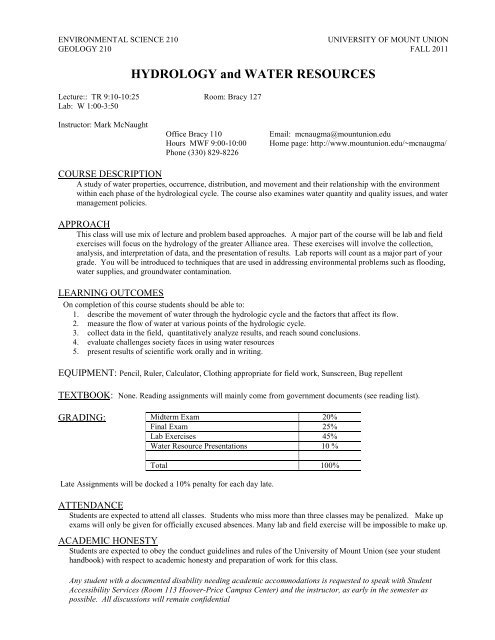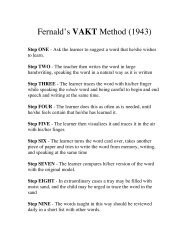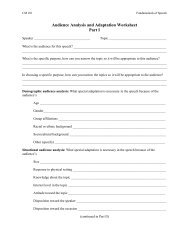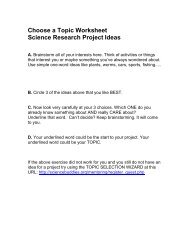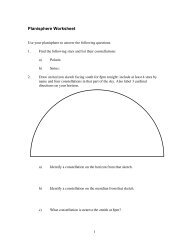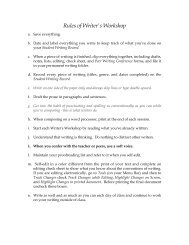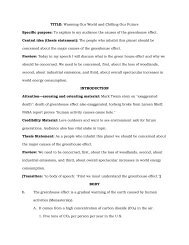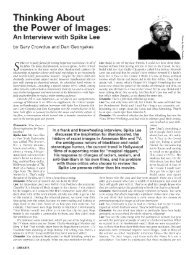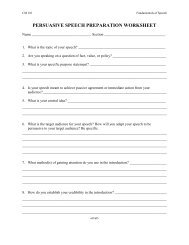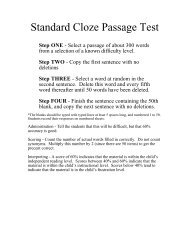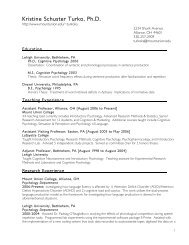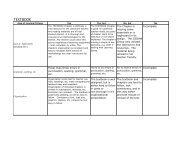Hydrology Syllabus - University of Mount Union
Hydrology Syllabus - University of Mount Union
Hydrology Syllabus - University of Mount Union
Create successful ePaper yourself
Turn your PDF publications into a flip-book with our unique Google optimized e-Paper software.
ENVIRONMENTAL SCIENCE 210<br />
GEOLOGY 210<br />
UNIVERSITY OF MOUNT UNION<br />
FALL 2011<br />
HYDROLOGY and WATER RESOURCES<br />
Lecture:: TR 9:10-10:25 Room: Bracy 127<br />
Lab: W 1:00-3:50<br />
Instructor: Mark McNaught<br />
Office Bracy 110<br />
Hours MWF 9:00-10:00<br />
Phone (330) 829-8226<br />
Email: mcnaugma@mountunion.edu<br />
Home page: http://www.mountunion.edu/~mcnaugma/<br />
COURSE DESCRIPTION<br />
A study <strong>of</strong> water properties, occurrence, distribution, and movement and their relationship with the environment<br />
within each phase <strong>of</strong> the hydrological cycle. The course also examines water quantity and quality issues, and water<br />
management policies.<br />
APPROACH<br />
This class will use mix <strong>of</strong> lecture and problem based approaches. A major part <strong>of</strong> the course will be lab and field<br />
exercises will focus on the hydrology <strong>of</strong> the greater Alliance area. These exercises will involve the collection,<br />
analysis, and interpretation <strong>of</strong> data, and the presentation <strong>of</strong> results. Lab reports will count as a major part <strong>of</strong> your<br />
grade. You will be introduced to techniques that are used in addressing environmental problems such as flooding,<br />
water supplies, and groundwater contamination.<br />
LEARNING OUTCOMES<br />
On completion <strong>of</strong> this course students should be able to:<br />
1. describe the movement <strong>of</strong> water through the hydrologic cycle and the factors that affect its flow.<br />
2. measure the flow <strong>of</strong> water at various points <strong>of</strong> the hydrologic cycle.<br />
3. collect data in the field, quantitatively analyze results, and reach sound conclusions.<br />
4. evaluate challenges society faces in using water resources<br />
5. present results <strong>of</strong> scientific work orally and in writing.<br />
EQUIPMENT: Pencil, Ruler, Calculator, Clothing appropriate for field work, Sunscreen, Bug repellent<br />
TEXTBOOK: None. Reading assignments will mainly come from government documents (see reading list).<br />
GRADING:<br />
Midterm Exam 20%<br />
Final Exam 25%<br />
Lab Exercises 45%<br />
Water Resource Presentations 10 %<br />
Total 100%<br />
Late Assignments will be docked a 10% penalty for each day late.<br />
ATTENDANCE<br />
Students are expected to attend all classes. Students who miss more than three classes may be penalized. Make up<br />
exams will only be given for <strong>of</strong>ficially excused absences. Many lab and field exercise will be impossible to make up.<br />
ACADEMIC HONESTY<br />
Students are expected to obey the conduct guidelines and rules <strong>of</strong> the <strong>University</strong> <strong>of</strong> <strong>Mount</strong> <strong>Union</strong> (see your student<br />
handbook) with respect to academic honesty and preparation <strong>of</strong> work for this class.<br />
Any student with a documented disability needing academic accommodations is requested to speak with Student<br />
Accessibility Services (Room 113 Hoover-Price Campus Center) and the instructor, as early in the semester as<br />
possible. All discussions will remain confidential
Tentative Schedule (Changes may be made based on weather conditions)<br />
Date Week Topic Reading *<br />
1 Introduction to the Hydrologic Cycle # 1<br />
Reading Topographic Maps<br />
#2<br />
Geology<br />
#3<br />
Aug 30<br />
31<br />
Sept 1<br />
6<br />
7<br />
8<br />
13<br />
14<br />
15<br />
20<br />
21<br />
22<br />
27<br />
28<br />
29<br />
Oct. 4<br />
5<br />
6<br />
11<br />
12<br />
13<br />
18<br />
19<br />
20<br />
25<br />
26<br />
27<br />
Nov.1<br />
2<br />
3<br />
8<br />
9<br />
10<br />
15<br />
16<br />
17<br />
22<br />
23, 24<br />
29<br />
30<br />
Dec 1<br />
6<br />
7<br />
8<br />
2 Geologic Materials and Geologic Maps<br />
FT Local Geology<br />
Precipitation #4<br />
3 Spreadsheets<br />
Precipitation Analysis<br />
Report Prep.<br />
4 Evapotranspiration<br />
Properties <strong>of</strong> Geologic Materials<br />
Report Prep<br />
5 Soils and Infiltration<br />
FT Infiltration measurement<br />
Report Prep<br />
6 Drainage Basins<br />
Mahoning River Basin Analysis<br />
TBA<br />
7 Stream Flow<br />
FT Stream Gaging<br />
Report Prep<br />
8 Water Pollution<br />
FT Water Chemistry<br />
MIDTERM EXAM<br />
9 Run<strong>of</strong>f and Flooding<br />
Flood Plain Mapping<br />
Hydrograph Calculation<br />
10 Introduction to Groundwater<br />
Ground Water Model and Darcy’s Law<br />
Aquifers Properties<br />
11 Flow to Wells<br />
FT Aquifer analysis<br />
Report Prep<br />
12 Groundwater Flow<br />
Ground Water Mapping and Modeling<br />
Groundwater Models<br />
13 Contaminate Hydrogeology<br />
Thanksgiving Break<br />
14 Contaminate Hydrogeology Exercise<br />
Contaminate Hydrogeology Exercise<br />
Contaminate Hydrogeology Exercise<br />
Water Resource Presentations<br />
Contaminate <strong>Hydrology</strong><br />
Water Resource Presentations<br />
#5<br />
#6<br />
#7<br />
#8:<br />
#12<br />
#9, #10<br />
#11<br />
#13; #14: pp. 1-27<br />
#14: 28-63<br />
15 Final Exam (8:00 AM Thur. Dec. 15 th )<br />
* # ‘s refer to papers on reading list. Additional Reading assignments may be assigned.<br />
#14: pp. 64-77; #15
Reading List<br />
1. Brown, L.C., 1994, Ohio’s Hydrologic Cycle, Ohio State <strong>University</strong> Extension Fact Sheet AEX-461-94.<br />
http://ohioline.osu.edu/aex-fact/0461.html<br />
2. Topographic maps web page, parts I-VIII:<br />
http://raider.mountunion.edu/~mcnaugma/Topographic%20Maps/topomapindexpage.htm<br />
3. Coogan, A.H., 1996, Ohio’s Surface Rocks and Sediments, in Feldmann and Hackathorn, eds., Fossils <strong>of</strong> Ohio, Ohio<br />
division <strong>of</strong> Geological Survey Bulletin 70. http://www.dnr.state.oh.us/Portals/10/pdf/OH_SurfaceRocks_Sediments.pdf<br />
Hansen, M.C., 1997, Ice Age Ohio, Ohio Geological Survey Educational Leaflet no. 7.<br />
http://www.ohiodnr.com/Portals/10/pdf/EL/el07.pdf<br />
4. Point Precipitation Measurements web page http://www.srh.noaa.gov/abrfc/n=map<br />
5. ODNR Division <strong>of</strong> Soil and Water Resources - Introduction to Soils<br />
(http://www.dnr.state.oh.us/H_Nav2/Soils/OhiosSoils/IntroductiontoSoils/tabid/17818/Default.aspx)<br />
ODNR Division <strong>of</strong> Soil and Water Resources - Soil Regions<br />
(http://www.dnr.state.oh.us/soilandwater/soils/SoilRegions/tabid/9073/Default.aspx)<br />
ODNR Division <strong>of</strong> Soil and Water Resources - Pictures <strong>of</strong> Soil Types<br />
(http://www.dnr.state.oh.us/H_Nav2/Soils/OhiosSoils/Pictures<strong>of</strong>SoilTypes/tabid/17831/Default.aspx)<br />
6. ______, 2006 Pennsylvania Stormwater Best Management Practices Manual.<br />
http://www.elibrary.dep.state.pa.us/dsweb/View/Collection-8305 . Read Appendix C<br />
7. <strong>Mount</strong>, J. F., 1995, California Rivers and Streams: The Conflict Between Fluvial Process and Land Use, <strong>University</strong> <strong>of</strong><br />
California Press. Electronic Version <strong>of</strong> the book can be reached through our library catalog . Read Chapter 4.<br />
8 Michaud, J.P. 1991, A citizen’s Guide to Understanding and Monitoring Lakes and Streams, Washington State<br />
Department <strong>of</strong> Ecology, http://www.ecy.wa.gov/pubs/94149.pdf<br />
9. ______ ,2005, Ohio Floodplain Management Handbook, Ohio Department <strong>of</strong> Natural Resources, Division <strong>of</strong> Water.<br />
http://www.dnr.state.oh.us/Portals/7/floodpln/oh_floodplain_handbook.pdf. Read Chapters 1, 2, 4.<br />
10. ______, 1981, Guidelines for determining Flood Flow Frequency, Interagency Advisory Committee on Water Data<br />
Bulletin 178. http://water.usgs.gov/osw/bulletin17b/bulletin_17B.html. Pages to be read to be determined.<br />
11. ______ ,1986, Urban <strong>Hydrology</strong> for Small Watersheds, Natural Resources Conservation Service TR-55.<br />
http://www.cpesc.org/reference/tr55.pdf Read chapters 1-4.<br />
12. _______, 1997, Volunteer Stream Monitoring: A Methods Manual, US EPA,<br />
http://www.epa.gov/volunteer/stream/stream.pdf . Read chapters 2 and 5.<br />
13. Winter, T.C., Harvey, J.W., Franke, O.L., Alley, W.M.., 2006, Ground Water and Surface Water a Single Resource, US<br />
Geological Survey Circular 1139. http://pubs.usgs.gov/circ/circ1139/#pdf<br />
14. Heath, R. C., (2004) Basic Ground-Water <strong>Hydrology</strong>, USGS Water Supply Paper 2220,<br />
http://pubs.er.usgs.gov/usgspubs/wsp/wsp2220<br />
15. ______ , 2006, Volatile Organic Compounds in the Nation’s Groundwater and Drinking-Water Supply Wells,<br />
USGS Circular 1292, http://pubs.usgs.gov/circ/circ1292/. Read Chapters 2,3,4,5.


